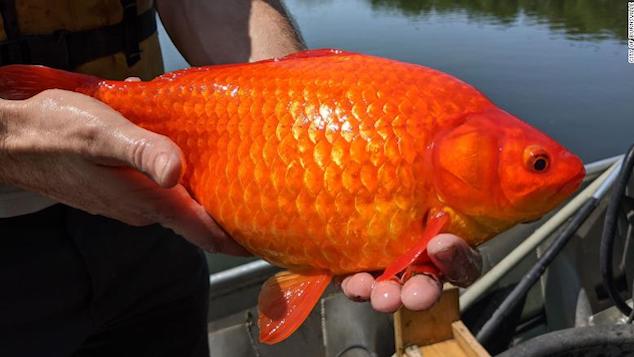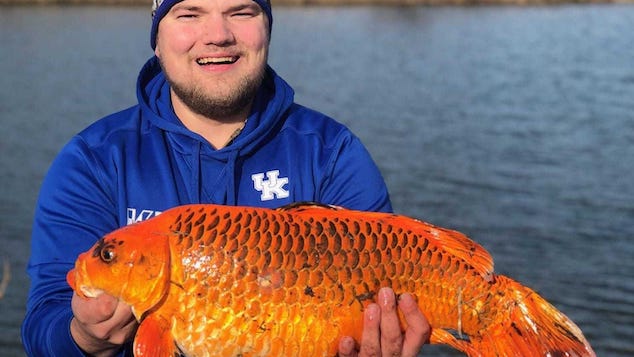
Giant Goldfish in Minnesota: How pet goldfish have led to poor water quality in local lakes and ponds and the uprooting of the local ecosystem.
Not a Mini problem!
In Minnesota, gigantic goldfish are causing trouble. Residents and owners of pet goldfish in Burnsville have been reminded not to discard the family pet in lakes and ponds. The authorities issued a warning, stating that doing so had resulted in overgrown goldfish taking over one nearby lake.
‘They grow bigger than you think,’ authorities said on Twitter, ‘and contribute to poor water quality by mucking up bottom sediments and uprooting vegetation.‘ These huge goldfish were recently discovered in Keller Lake in a large group. Instead of being a household pet full of entertainment and joy, they are causing havoc!
It isn’t the first time that Minnesota lakes have become inundated with colossal goldfish. Thousands of goldfish were discovered swimming in Big Woods Lake in Chaska, a Minneapolis suburb, in November. Due to environmental difficulties posed by the goldfish, a team had to remove a truckload of 500,000 goldfish. The issue has also arisen in Boulder and Lake Tahoe, where biologists discovered thousands of goldfish in nearby lakes years ago. Dumping unwanted goldfish into a local pond is against the law in most places, including Minnesota, where the issue has recently surfaced.
It’s known as illegal fish stocking, and it’s been seen all around Minnesota. This disrupts the normal balance of fish communities and spreads disease. Goldfish are classified as invasive species, because they uproot underwater plants and compete for food and shelter with local fish. In addition, the fish are prolific reproducers who can live up to 25 years and are extremely difficult to remove.
The United States isn’t the only country plagued with greedy goldfish. The city government of Munich, Germany, reported in 2017 that shoals of goldfish were starving out all competitors in local ponds and lakes. The situation became so severe that the city council threatened to penalise anyone who released their pets into public waters. Giant goldfish have also been discovered in the natural waters of the United Kingdom.
A brief history lesson
It’s all our fault that goldfish are overtaking lakes and streams around the planet. If you think releasing the goldfish is a good idea, think again! Instead, you’re causing an ecological calamity that could put hundreds of other species in jeopardy. Goldfish, it turns out, are one of the world’s most invasive species. Goldfish were first carefully developed for food in China around 2,000 years ago.
Goldfish had progressed from being a food source to being a source of amusement by the 14th century. It wasn’t long before pet owners helped them spread over the world, and by the nineteenth century, they had reached North America.
They may appear tiny and charming in your home, but out in the wild, they are much different. These small orange creatures will grow to be giants if given enough time and resources, weighing up to 4 pounds (2 kilogrammes), approximately the size of an American football! Plants, insects, crabs, and other fish are all eaten by these large fish. But they’re not simply eating what other fish need to survive; their voracious feeding period also stirs up mud and debris, potentially causing damaging algae blooms that suffocate the ecosystem.
Weighing in
Goldfish are a species of domesticated carp bred primarily to provide people with easy-to-care-for, relaxing pets to keep in their homes or backyard ponds. When released into the wild or housed in huge cages, goldfish are said to expand to match their surroundings, reaching incredible sizes. But how big can these goldfish get before they die? Let’s look at some of the biggest ever discovered.

Bruce The Red Oranda – 14 Inches Long – China
Jackie and Louis Chan, two fish farming brothers from Hong Kong, bred this pleasantly chubby specimen. They ended up with Bruce, whose size has been compared to that of a house cat, after meticulously raising Red Oranda goldfish to secure themselves a spot in the Guinness Book of World Records. According to the Chan brothers, Bruce’s size is due to careful breeding, a healthy diet, and enough activity.
Goldie The Goldfish – 15.7 Inches Long – England
Goldie the goldfish is not just large, but he’s also rather elderly at 15 years old. Since his tank partner died, his owner, 83-year-old widow Ada Shaw, has taken excellent care of him as her solitary company. He likes to be active, she explains, because they keep each other company, and he has a dominating nature.
Billy The Goldfish – 16 Inches Long – England
Nick Richards’ massive goldfish, collected in Dorset Lake, was formerly the world’s most giant goldfish. Nick was fishing for common carp when he saw an exceptionally intense flash of orange and decided to cast his line. He thought he’d captured an enormous carp at first, but closer scrutiny revealed that his catch was an enlarged goldfish that had most likely been a pet.
Monster – 18 Inches Long – USA
Goldfish specimens of incredible size were discovered while scientific researchers were scouring the waters of Lake Tahoe for invasive species. Around 15 of these enormous goldfish were spotted schooling in a corner of the lake, indicating that they were reproducing. This was cause for alarm, as goldfish are an invasive species in Lake Tahoe, inflicting ecosystem devastation.






